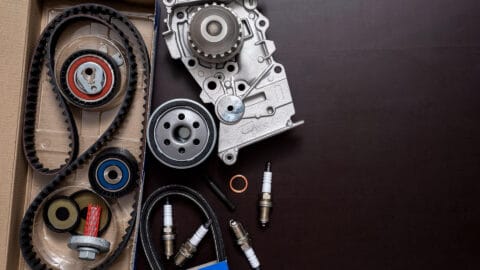What is a timing belt and why replace it?
Timing belts have replaced timing chains and are on many of today’s engines. Belts and chains ensure that the crankshaft, pistons and valves operate together in proper sequence. Belts are lighter, quieter and more efficient than chains.
Both components are crucial to the proper operation of the vehicle and usually need periodic replacement (unless your vehicle is equipped with a time chain—which doesn’t usually need replacement). Lets check out below as to how these components operate and the related internal components of the timing belt and water pump system.
Check your owner’s manual for the proper interval to replace your timing belt and water pump or stop in and have one of our service experts review your vehicle’s maintenance needs with you one-on-one. Generally, the idler pulleys, tensioner and water pump should always be replaced when the timing belt is replaced. In most cases, the timing belt drives the water pump, so it is the right time to replace the water pump. It is also recommended by the manufacturer.
Here’s the deal:
The less scrupulous repair center gives you a low-ball estimate to do either the timing belt or the water pump…minimal parts cost and minimal labor. They get you in and your car disabled on the hoist, then they call and say, “Guess what you need…???” You guessed it…you need the whole timing belt and water pump kit which includes the other smaller worn mechanical components (i.e. new idler pulley, new timing belt tensioner) that your quote should’ve included in the first place).
The vast majority of the time, it makes complete maintenance and dollar sense to do the “whole enchilada” at the same time — the timing belt, water pump, tensioner and idler pulley (as equipped) — because if it’s time for one, the other units are usually not far behind. Check your owner’s manual for details.
The labor cost difference to do both units at the same time is virtually non-existent in most vehicles because, in many cases, you must remove the water pump to get to the timing belt! The cost of most water pumps is minimal when compared to having to pay all that labor AGAIN, plus cost of a water pump, in the not-so-distant future when the water pump blows out!
In our humble opinion, it’s deceptive not to quote you the real total cost to get both the timing belt AND the water pump + the small ancillary parts all done at the same time.
How does a car’s water pump work?
As a vehicle’s engine operates, it generates high temperatures within the motor. This heat must be handled appropriately, and the motor kept cooled at a proper operating temperature range, or the vehicle will suffer potentially catastrophic failure…you’ll blow it up. Generally, a vehicle’s water pump, driven by the motor via the timing belt (or serpentine belt in some models), circulates the coolant/antifreeze around the “water jacket” of the motor, and back through the radiator thus cooling it. It also facilitates circulating coolant/antifreeze through the heater core of the car so you can stay warm in the winter.
In case you did not know: coolant & antifreeze are essentially one and the same.
Since its operation is controlled by engine activity, the water flow-rate of this pump is regulated by engine’s RPM. A thermostat is also in the loop. It essentially helps in regulating the flow of the coolant, based on the engine’s temperature. As the engine RPM and temperature increases, so does the rate of water flow. That helps in maintaining a proper engine temperature. The timing belt runs the water pump and maintaining both is critical to a vehicle’s operation and longevity.
When Should the Serpentine Belt(s) Be Replaced?
When a timing belt breaks, the engine stops…meaning it is not going to get you where you want to go. Serpentine belts help ensure proper operation of the alternator, power steering and water pump.
If this belt breaks or snaps you will be able to continue driving, however if the alternator isn’t moving it will eventually lose power and die. Consequently, the power steering will eventually lock up and become incredibly difficult if not impossible to turn the wheel and force any driver to pull over.
When this happens it is in the best interest of your safety and the vehicle to get your vehicle into a trusted repair facility (hint hint – Harmony Automotive) to make sure all components are healthy and working properly.
So proactively check out your ‘serp belts’ or have a trusted technician replace the belt(s) before they break or get loose and come off.


